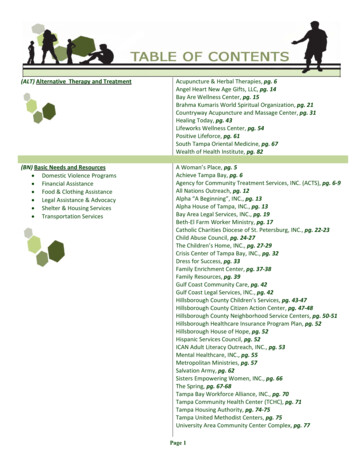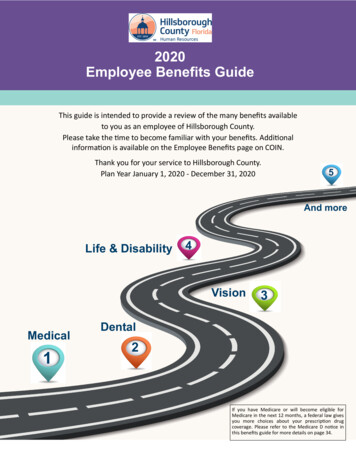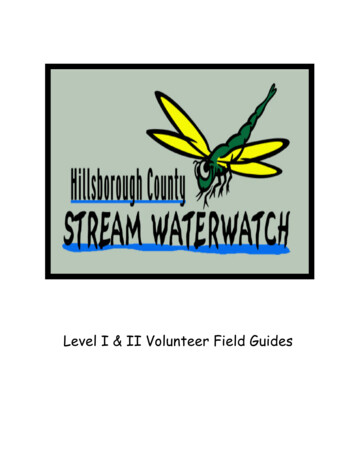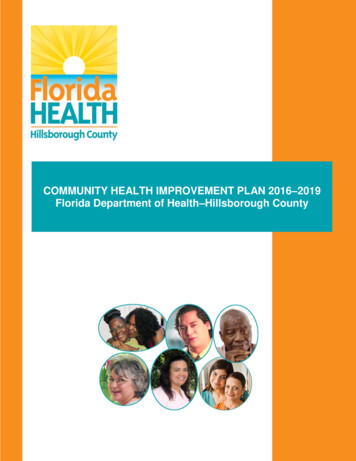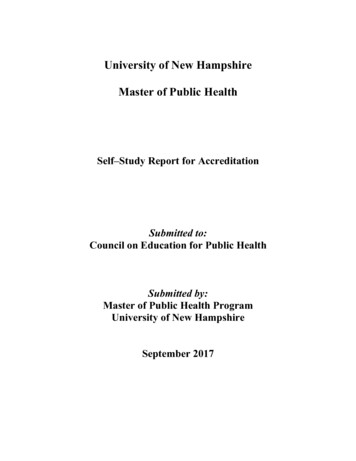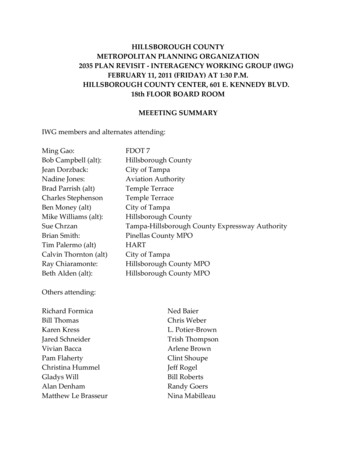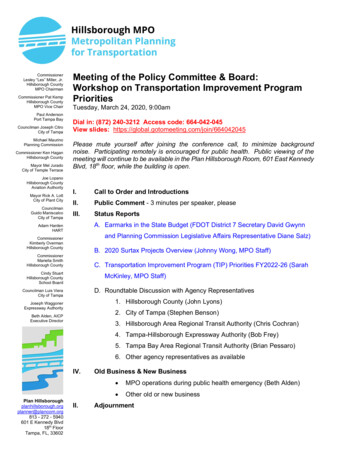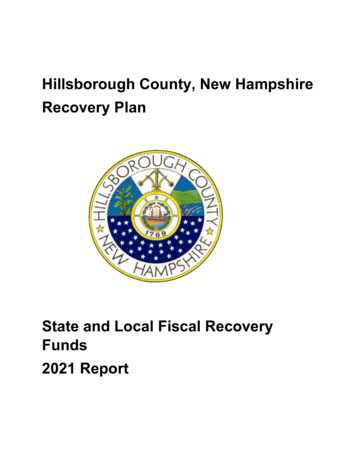
Transcription
Hillsborough County, New HampshireRecovery PlanState and Local Fiscal RecoveryFunds2021 Report
Hillsborough County, New Hampshire2021 Recovery PlanTable of ContentsGeneral Overview .2The American Rescue Plan .3SLRF Funds Allocated in Hillsborough County .5The Role and Function of County Government .6Executive Summary .12The Path Forward .14Uses of Funds .17Subsequent Reporting.22Promoting Equitable Outcomes .23Community Engagement .24Labor Practices .24Use of Evidence .24Table of Expenses by Expenditure Category .24Project Inventory.26Ineligible Activities: Tax Offset Provision .27Hillsborough County’s Recover Plan will fully comply with the Treasury’s Interim Final Rule andthe SLFR funds received by Hillsborough County will be allocated prior to the December 31,2024 deadline and that all SLFR expenditures will be completed by December 31, 2026, asrequired by federal law.Hillsborough County, New Hampshire 2021 Recovery Plan Performance Report1
GENERAL OVERVIEWThe intent of the first annual Hillsborough County Recovery Plan Performance is to not onlycomply with the United States Department of the Treasury’s compliance and reportingguidelines for the award terms and conditions but to also to educate the public on: The key provision of the American Rescue Plan Act applicable to Hillsborough County:the Coronavirus State and Local Fiscal Recovery Funds;The Coronavirus State and Local Fiscal Recovery Funds allocated in HillsboroughCounty;The role and function of county government in Hillsborough County;Hillsborough County’s response to the pandemic and actions during the reporting period;The United States Department of the Treasury’s required information for the reportingperiod 1; andAn overview of Hillsborough County’s planned use of SLFR Funds to date 2.Subsequent Recovery Plan Performance Report’s (herein “Recovery Plan”) will provide updateson any projects listed in this first Recovery Plan as well as future uses of funds to ensureprogram outcomes are achieved in an effective, efficient, and equitable manner.A guiding principle of Hillsborough County’s first annual Recovery Plan is in response to selectReporting Requirements and Process - Frequently Asked Questions found in the United StatesDepartment of Treasury’s Portal for Recipient Reporting: State and Local Fiscal RecoveryFunds, dated August 9, 2021. Specifically, when reviewing this Recovery Plan, the public shouldbe aware of the following FAQs:1.1.If a recipient has received funding as of July 15, 2021 but has not incurred obligations orexpenditures as of the end of the reporting period, what are the reporting requirements?Interim Report: Recipients should submit a report showing no ( ) obligations or expenditureshave yet been incurred.Recovery Plan: Recipients should submit a Recovery Plan describing the planned approach tothe use of funds and planned projects. (emphasis added).1.2.If a recipient has received funding as of July 15, 2021 but has not established projects as of theend of the reporting period, what are the reporting requirements?No project level reporting is required in the Interim Report. Recipients should submit a RecoveryPlan describing the planned approach to the use of funds and planned projects. (emphasisadded).1From the Award Date to July 31, 2021Identified potential programs, projects, and initiatives are subject to review and consideration of the HillsboroughCounty Board of Commissioners, Hillsborough County Executive Committee and as required by law theHillsborough County Delegation.2Hillsborough County, New Hampshire 2021 Recovery Plan Performance Report2
1.5.Should recipients submit a Recovery Plan if they are awaiting approval by legislative or othergovernance entities on the proposed projects, and such approval is not received as of the end ofthe reporting period?Recipients should submit a Recovery Plan that includes information about any projects that areapproved or authorized for release by August 31, 2021. A recipient should then submit anupdated Recovery Plan within 60 days after approval by the legislature or other governanceentities. (emphasis added).This Recovery Plan will cover the period from the date of award to July 31, 2021 and must besubmitted to Treasury by August 31, 2021. Thereafter, subsequent Recovery Plans will cover a12-month period and Hillsborough County will be required to submit the report to the UnitedStates Department of Treasury within 30 days after the end of the 12-month period (by July 31)and as indicated below:Annual Report1234567Period CoveredAward Date – July 31, 2021July 1, 2021 – June 30, 2022July 1, 2022 – June 30, 2023July 1, 2023 – June 30, 2024July 1, 2024 – June 30, 2025July 1, 2025 – June 30, 2026July 1, 2026 – December 31, 2026Due DateAugust 31, 2021July 31, 2022July 31, 2023July 31, 2024July 31, 2025July 31, 2026March 31, 2027The American Rescue PlanOn March 11, 2021, President Biden signed the American Rescue Plan Act of 2021 (H.R.1319)(here in “ARPA”) into law. ARPA’s 1.9 trillion package is intended to combat the COVID-19pandemic, including the public health and economic impacts. A key provision under ARPA is theCoronavirus State and Local Fiscal Recovery Funds (herein “SLFR Funds”) which provides 350 billion in relief to states and local governments to combat the continued impact of theCOVID-19 pandemic. Of the 350 billion SLFR Funds, 65.1 billion is provided in direct aid tocounties across the Country. The funds are to help turn the tide on the pandemic, address itseconomic fallout and lay the foundation for a strong and equitable recovery. According to theUnited Stated Department of Treasury (herein “Treasury”), the key objectives of the SLFRFunds are to: Support the urgent COVID-19 response efforts to decrease spread of the virus and bringthe pandemic under control.Replace lost revenue for eligible recipients to strengthen support for vital public servicesand help retain jobs.Support immediate economic stabilization for households and businesses.Address systemic public health and economic challenges that have contributed to theinequal impact of the pandemic on certain populations.To execute the key objectives of the SLFR Funds, Treasury has outlined specific ways in whichrecipients may invest funds:Hillsborough County, New Hampshire 2021 Recovery Plan Performance Report3
1. Support public health response: Fund COVID-19 mitigation efforts, medical expenses,behavioral health care and certain county public health, public safety, human servicesand other related staff.2. Address negative economic impacts: Respond to economic harms to workers,families, small businesses, impacted industries and rehiring of public sector workers,including County staff.3. Services to disproportionately impacted communities: Education assistance,healthy childhood environments, housing support and community violence interventions.4. Premium Pay for Essential workers: Offer additional compensation, to those – bothcounty employees and other essential workers in the community – who have faced andcontinue to face the greatest health risks due to their service.5. Water, Sewer and broadband infrastructure: Make necessary investments to improveaccess to clean drinking water, invest in wastewater and stormwater infrastructure andprovide unserved or underserved locations with new or expanded broadband access.6. Replace public sector revenue loss: Use funds to provide government services to theextent of the reduction in revenue experienced during the pandemic – this provisionallows a much broader use of Funds.7. Administrative: Covering the cost of payroll and benefits of employees correspondingto time spent on administrative work necessary due to the COVID-19 public healthemergency and its negative economic impacts. This includes, but is not limited to, costsrelated to disbursing payments of SLRF Funds and managing new grant programsestablished using SLRF Funds. Additionally, recipients may use funds for administeringthe SLRF Funds program, including costs of consultants to support effectivemanagement and oversight, including consultation for ensuring compliance with legal,regulatory, and other requirements.Within these categories, recipients have flexibility to decide how best to use this funding to meetthe needs of their communities.In addition to outlining the eligible uses of SLRF Funds, Treasury has outlined specificineligible uses of the SLRF Funds: Changes that reduce net tax revenue must not be offset with the SLRF funds. No recipient may use this funding to make a deposit to a pension fund. Other ineligible uses include funding debt service, legal settlements or judgments, anddeposits for a “rainy day” fund or financial reserves. Other restrictions apply to eligible uses.To that end, the Hillsborough County Board of Commissioners believes it is important to identifythe core functions and responsibilities of Hillsborough County as a government entity. ThoseCounty core functions are: nursing home long term care as both a direct service provider and apayer source of long term care within the county, county corrections, and criminal justice. TheHillsborough County Board of Commissioners may also identify existing county partnership andprojects with non-profits or other non-governmental organizations (herein “NGOs”) who performservices directly relating to County responsibilities as “core functions” for purposes of SLRFfunding. Moreover the Hillsborough County Board of Commissioners will carefully review thoseHillsborough County, New Hampshire 2021 Recovery Plan Performance Report4
permitted uses of SLRF Funding in the award of any grants to governmental subdivisions orother NGOs.SLFR Funds Allocated in Hillsborough CountyThe total SLFR Funds received by the State of New Hampshire and all municipalities is 994,555,877.60Hillsborough County is not the only governmental entity to receive SLFR Funds within itsgeographic borders. Below is a list of municipalities in Hillsborough County and the amounts ofSLFR Funds available to unicipalities within Hillsborough County 1,217,917Hillsborough 594,203New Boston 5,384,006 226,312Hollis 792,601New Ipswich 533,912 2,240,191Hudson 2,536,303Pelham 1,407,792 150,085Litchfield 855,466Peterborough 662,118 539,852Lyndeborough 171,469Sharon 36,531 195,329Manchester 44,346,733Temple 140,779 156,718Mason 141,868Weare 900,017 1,787,262Merrimack 2,622,532Wilton 375,114 182,855Milford 1,624,703Windsor 22,8693 208,892Mont Vernon 263,243TOTAL SLFR Funds in County : 163,945Nashua 16,564,916 87,046,533This figure does not include the allotted 81,002,217 SLRF Funds that Hillsborough County itself will receive.Hillsborough County, New Hampshire 2021 Recovery Plan Performance Report5
The public is encouraged to visit the above municipalities’ website(s) to understand how theirmunicipalities are investing their SLRF Funds.Hillsborough County itself has received 40,501,108.50 in SLRF Funds and is expected toreceive the corresponding amount in May 2022 for a total of 81,002,217.With significant SLRF Funds noted above, the Hillsborough County Board of Commissionersintend to be mindful of other municipalities SLRF Fund plans in order to avoid duplication offunding that a town or city would more appropriately address with their allocations of SLRFFunds and to maximize the impact of all SLFR Funds within Hillsborough County’s departmentsand the community.As of the 2020 Census, out of the 1,377,529 residents in the State of New Hampshire 422,937residents (30.70%) live in Hillsborough County. Having the highest percentage of the state’sresidents living in Hillsborough County, the Hillsborough County Board of Commissioners arecognizant that the County has access to funding opportunities under the eligible uses of theSLRF Funds. This will help turn the tide on the pandemic, address its economic fallout, and laythe foundation for a strong an equitable recovery, within its core Constitutional and statutoryobligations and related responsibilities to a significant amount of residents in the State of NewHampshire.The Role and Function of County GovernmentIn examining the intended functional delivery of SLRF Funds in Hillsborough County the publicshould be aware of the structure of county government in New Hampshire, and its core servicesand responsibilities to the public.Structure of New Hampshire County GovernmentNew Hampshire government is defined by its division of state, county and municipal servicesand their responsibilities pursuant to the United States and New Hampshire Constitutions,federal and state law, and case law. County government is rooted in a unique combination oftradition and efficiency. The current structure of county government is modelled after abicameral system of government.The County Commissioners make up the Executive Branch with the elected constitutionalofficers and appointed county officials 4, the County Delegation makes up the Legislative Branch.Executive Brancha)4Board of County CommissionersSupervised and appointed by the Board of Commissioners.Hillsborough County, New Hampshire 2021 Recovery Plan Performance Report6
Each county has a three-member elected board of commissioners which is responsible for theday-to-day operations of county government, in both fiscal and policy matters as mandated byNew Hampshire Revised Statute Annotated (NH RSA) 28. The Board elects a chair, vice-chairand clerk and meets formally to conduct county business.The Board of Commissioners has responsibility for the general management and control of thefinancial affairs of Hillsborough County, including the management and control of its property.The Commissioner’s duties are mandated by statute as set forth in New Hampshire RSAChapter 28.The Commissioners sit as a Board, exercising their rights, authority and powers by avote of the majority. The Board meets regularly throughout the year to carry out its responsibilityfor overall day-to-day financial management and control of county assets and liabilities.The Commissioners have authority to implement administrative policies and procedures tosafeguard the County’s assets and monitor its financial liabilities. The Commissioners arerequired to employ such number of clerks and agents as they deem necessary and to adopt andestablish rules and procedures for the discharge, removal, or suspension of County employees.Exercising their authority, the Commissioners review and approve all expenditures, competitivebids, contracts, and budget transfer requests. They negotiate collective bargaining agreementswith six employee bargaining units, and consider employee grievances. The Commissionersinitiate, direct, and resolve all litigation on behalf of the County. They are also responsible, on anannual basis, for submitting to the Executive Committee of the County Delegation and to eachmember of the County Convention an itemized budget recommendation for County operationsfor the next year.b) Appointed OfficialsAcross the ten counties there are approximately 4,600 employees providing services to NHcitizens. Major county departments are organized by function as follows1) County Administrators/ManagersCounty Administrators and Managers are a creation of the boards of countycommissioners. Unlike city and town administrators and managers, countyadministrators/managers have no statutory authority. All authority vested in countyadministrators/managers is at the sole discretion of the boards of county commissioners.The responsibilities vary greatly from county to county, depending on the size,complexity and philosophy of the county.2) County Nursing Home AdministratorsThe counties operate eleven nursing homes, one in each county with the exception ofCoos County, which has two nursing homes. County nursing homes provide long termcare and rehabilitation services to all qualifying citizens but generally have higherproportions of Medicaid residents than non-county nursing homes. County nursing homeadministrators are responsible for developing, monitoring and evaluating the quality andappropriateness of care and treatment provided to nursing home residents.Nursing home administrators are required to be licensed by the State of NH under RSA151-A. The Board of Examiners of Nursing Home Administrators is responsible forHillsborough County, New Hampshire 2021 Recovery Plan Performance Report7
developing and enforcing professional stands for all nursing home administrators. Thereare a variety of medical professionals providing care and treatment at nursing homesand there are corresponding state boards responsible for the development andenforcement of professional standards. In addition, the New Hampshire Department ofHealth and Human Services conducts annual, onsite evaluation of all nursing homes toensure compliance with Medicaid/Medicare regulations.The majority of county workers are employed at the eleven county nursing homes. Theyprovide compassion, professionalism and commitment to quality of care for each of themore than 2,200 residents of county nursing homes.3) County Corrections SuperintendentsIn accordance with RSA 30-B, counties operate ten county departments of correctionswhich are responsible for the care, custody and control of adults awaiting trial, as well asadults sentenced to serve up to twelve (12) months. If the sentence is greater than oneyear, inmates serve their sentence at the New Hampshire State Prison. However, thereare instances when a person is sentenced to a term that exceeds 12 months ofimprisonment to a county corrections facility. For these instances, the expense oflodging a person in a county correctional facility is charged to the state or the state maytake physical custody of the inmate at that time.County corrections superintendents have statutory authority to grant work release orother programs deemed conducive to inmate rehabilitation within the rules of procedureapproved by the individual board of county commissioners.c) Constitutional OfficersCounty constitutional officers are created under Part 2, Section 71 of the New HampshireConstitution. Constitutional officers are elected and accountable to the voters. The Board ofCounty Commissioners provides budgetary oversight for the constitutional officers in eachCounty.1) County AttorneyThe county attorney serves as the chief law enforcement officer in their county. Thecounty attorney prosecutes all felonies committed in their jurisdiction except for first- andsecond-degree homicide and works in conjunction with the State Attorney General’soffice, sheriff’s department, New Hampshire state police and local police departments.2) County SheriffIn addition to their constitutional duties, county sheriffs receive legally mandatedauthorization from RSA 104:6. County sheriffs are the only law enforcement officers withState-wide police power in all 234 cities and towns in the State of New Hampshire.Hillsborough County, New Hampshire 2021 Recovery Plan Performance Report8
General duties include: rural patrols, criminal investigations, support of local lawenforcement initiatives, vehicle escorts, transport and control of inmates/juveniles,service of process, court security for NH Superior Courts, and the operation of lawenforcement and public safety dispatch systems.3) Register of DeedsThe Register of Deeds receives its legally mandated authorization from New HampshireConstitution, Part 2, Articles 71-72. The duties of the register are dictated by RSA’s andinclude the recording, reproduction and indexing of legal documents pertaining to realestate and the reporting to the cities and towns (for tax purposes) of all transfers ofproperty and the maintenance of records dating back to 1827. The register is alsoresponsible for collecting the State’s real estate transfer tax.Legislative Branch – County DelegationThe legislative branch of county government is comprised of the elected members of the StateHouse of Representatives. As such, State Representatives serve a dual role. StateRepresentatives are also members of the “county convention” which later became known as the"county delegation".The county delegation convenes in early December, following the State election, for the purposeof organizing and selecting its leadership. Each county delegation chooses an executivecommittee and elects a chair, vice-chair and clerk.The county delegation is directly responsible for appropriating public funds to support thefunctions of county government. The full Delegation meets formally to vote on county budgetseach year.Functions of New Hampshire County GovernmentWhile this overview does not offer a comprehensive assessment and analysis of the completerole of county government, it does examine several core services provided by HillsboroughCounty. These core services will be a major focus point in the approach and expenditure ofSLRF Funds.Long-Term CareThe county mission of providing long-term care is a historic one that dates back to 18th centurycounty farms and county hospitals. As the needs of the citizens changed over time, so did thedelivery of services. Counties serve a dual role as both a “direct provider”/operator of long termcare/rehabilitation services and “payer” of long-term care services provided by both for and notfor profit nursing home care operated by other entities within Hillsborough County.County Nursing Homes—Service ProvidersHillsborough County, New Hampshire 2021 Recovery Plan Performance Report9
The ten counties in New Hampshire operate eleven Nursing Homes to meet the needsof its frailest population.The Hillsborough County Nursing Home is located on a scenic hilltop in Goffstown, NewHampshire. The facility is a 300 bed Skilled and Intermediate Care facility whichincludes a 22-bed Behavioral Health Unit and a 50-bed Memory Car Unit.A diverse teem of over 400 caring individuals provide for the care, comfort, rehabilitation,safety and security of our county’s frail elderly population.County Government—Payer SourceLong Term Care costs are paid for primarily through Medicaid, which is a Federalprogram for the low income administered by the State. The Federal government funds50% of Medicaid costs and requires the State to fund the remaining 50%. In NewHampshire, the State portion of Long Term Care costs is funded by the Counties.Long Term Care costs include the costs for nursing home care as well as Home &Community Based Services (HCBS) and Choices for Independence (CFI) Waiverprograms for Medicaid eligible seniors.There are twenty-one (21) Medicaid certified nursing homes in Hillsborough County withthe capacity for approximately 2,250 residents. Additionally, a large spectrum oforganizations provides HCBS and CFI Waiver program services to seniors throughoutthe county.Funding Long Term Care services is the largest item in the County budget. NewHampshire has the second oldest population in the nation. Population estimates projectthis population to grow exponentially the years ahead, creating an even greater need forlong term services and supports in the County.The long term care system continues to be at the core of county government’s commitment tolocal and accountable delivery of services.This core function of county government in New Hampshire, i.e. the care of the elderly in countynursing homes and the payor source for elderly care consumes the majority of each county’sbudget in any fiscal year, and the impact of the pandemic on New Hampshire’s nursing homes(public and private) has been immense.Justice and Public SafetyAmong the most important jobs any government does is to protect the safety and welfare of itscitizens in a just and fair manner. In New Hampshire this effort is coordinated across all levelsand branches of government. County government’s role in criminal justice strikes the balancebetween the strong desire to protect public safety at the community level and finding appropriateeconomies of scale.Hillsborough County, New Hampshire 2021 Recovery Plan Performance Report10
Investigation and Prosecution of Criminal OffensesThe county attorney prosecutes the vast majority of criminal cases in New Hampshire focusingon all felony charges. Municipal governments coordinate local circuit court prosecution withcounty attorney offices in order to achieve continuity in case disposition thereby expanding therole of the County Attorney. The local nature of prosecution is the key to New Hampshire’sability to find a community balance between punishment and rehabilitation. This balance is notthe same in every setting and the regional, county-based system ensures that a one-size-fits-alljustice system is not imposed on its communities. The county attorney is also an elected official,which ensures both a level of public review and accountability.Care, Custody and Control of Adult OffendersNew Hampshire county corrections offer a well-coordinated structure for both pre-trial and shortterm incarceration with programs. Staying connected with family and community is a veryimportant part of county corrections and with the intent to help reduce recidivism. Countydepartments of corrections are governed by RSA 30-B and the NH Criminal Code.Public SafetyThe county sheriff has a critical role in law enforcement and local public safety activities. In NH,county sheriffs and deputies are empowered to operate statewide, across municipal and countyborders which offer a unique ability to investigate and act when needed. The growth in publicsafety needs has led many local town governments to work with county attorneys to prosecutelocal cases and to rely on regional county sheriff departments to dispatch local fire and policeservices.Sheriffs continue to provide security for the NH Superior Court system. Sheriffs are responsiblefor general security of the court house as well as the transportation and control of offenders oroffenders adjudicated in the criminal justice system. Corresponding duties in the civil law systeminvolve service of process and execution of Court orders that are a pivotal function of the Sheriffand ensure the orderly operation of the civil justice system, including service of domesticviolence petitions, evictions, child custody and other forms of formal process.Real Estate and Land RecordsRecording land transactions is among the first and original roles of county government. Manyregistries have original land records dating back to the 1800s and resources have been investedto preserve these historic records.The sale or purchase of a home or business is a big part of the state’s economy and theRegistry of Deeds has become one of the most visible county services. In recent years the tenRegistry of Deeds offices have begun modernize access to public records by developingsubscription services that allow internet access to documents.The task of maintaining and recording land records includes a wide set of responsibilities. Recording deedsHillsborough County, New Hampshire 2021 Recovery Plan Performance Report11
Recording state, federal, and local tax liens Setting local tax rates and assessments Collecting state real estate transfer tax Recording municipal land use recordsIncreasingly the volume and complexity associated with recording all public records has ledmany municipalities to begin recording land use records at the county registry. This includes plotplans, site plans and demolition plans.EXECUTI VE SUMMARYThe COVID-19 pandemic has placed an incredible challenge on government at all levels. Sincethe beginning of the pandemic Hillsborough County has had to navigate and manage the everchanging situation both in carrying out its regular responsibilities and adapting to protecting itsemployees, residents who utilize County services and individuals in the County’s care. As theUnited Nations, Department of Economic and Social Affairs stated, “by threatening disruption ofpublic service delivery, the COVID-19 pandemic touched a cardinal principle of public services,that of continuity.” The County was forced to quickly adapt and re-adjust the way in whichcontinued public services were and are delivered so as to minimize the negative impact of thepandemic on individuals and communities. While the pandemic disrupted services and usheredin lockdowns, one area that had to continue was government services.In addition to adapting public service deliverables, the County has had to deal with the f
The role and function of county government in Hillsborough County; Hillsborough County's response to the pandemic and actions during the reporting period; The United States Department of the Treasury's required information for the reporting period1; and 2An overview of Hillsborough County's planned use of SLFR Funds to date .

